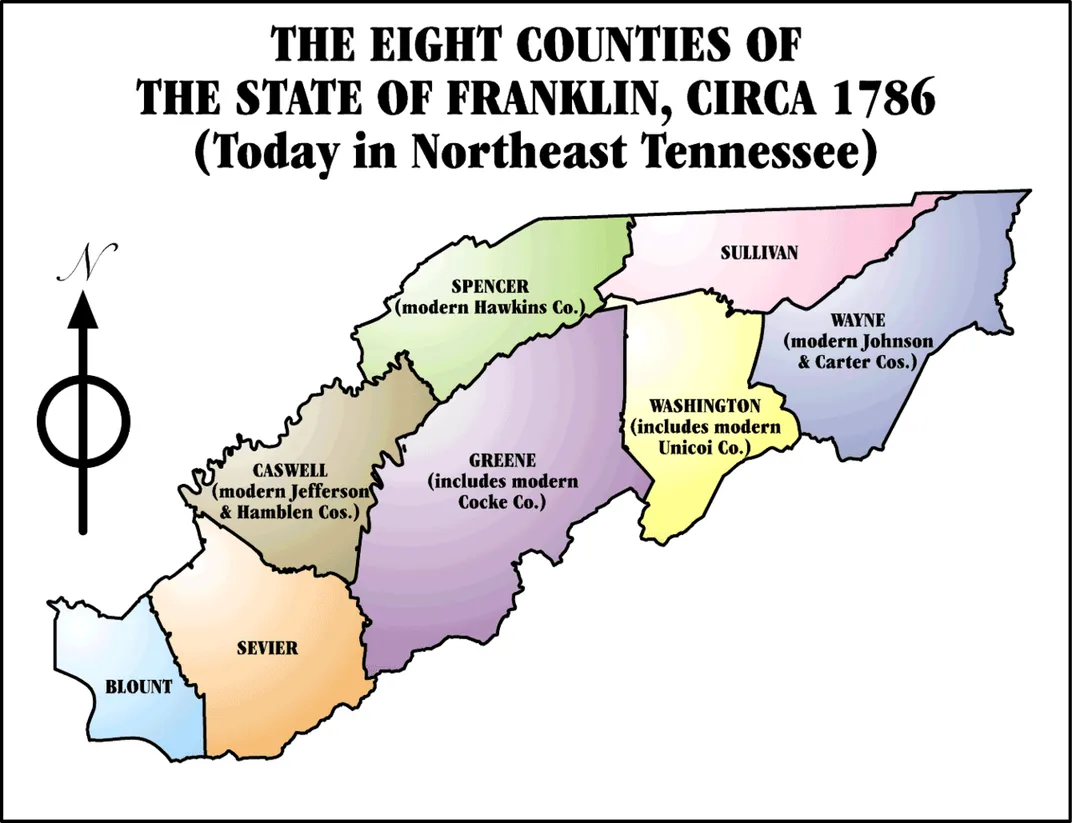The True Story of the Short-Lived State of Franklin
Several counties in what is today Tennessee tried to form their own independent state
/https://tf-cmsv2-smithsonianmag-media.s3.amazonaws.com/filer/48/1d/481dab24-e860-4aca-b5a6-c901d85a887d/franklin.jpg)
As the story of the lost State of Franklin shows, the American Revolution left some western communities in complicated circumstances.
After the war was won, communities west of the Appalachian Mountains and east of the Mississippi didn't default to becoming part of the United States. "It was never assumed," writes Jason Farr in The Tennessee Historical Quarterly. Instead, those communities “had the option of creating jurisdictions within existing states, forming new states within the union, or creating their own sovereign republics.” The residents of Franklin chose the middle option, feeling, as George Washington himself feared, that they had become “a distinct people” from those in the Atlantic states who fought for independence. The story of Franklin highlights how uncertain the early Union was and the rocky relationship between the original 13 Atlantic states and the West.
“There was little concern for western political and economic interests during the Confederation era,” Farr writes, “especially among the northeastern elite. Some even assumed that frontier communities would remain outside the union.” But when Franklin officially declared independence, as it did in 1784 starting with a conference on this day, it showed that the Founders had to pay more attention to the west.
At the time, the land of the State of Franklin was considered to have been four counties in North Carolina. However, North Carolina had ceded the land to the United States Congress in April 1784. The settlers in the region, which was known as the Cumberland River Valley, “were concerned that Congress would sell the territory to Spain or France as a means of paying off some of the government’s war debt,” writes History.com. In response to this worry, North Carolina took the territory back and started to organize it as part of the state.
But four counties decided they should make their own fate rather than waiting on North Carolina. The president of the convention of delegates that made this decision chose John Sevier, a Revolutionary War veteran, as president.

In December 1784, Franklin declared itself to be an independent state, rather than part of the union–although, as George W. Troxler notes in the Encyclopedia of North Carolina, Franklin wasn’t aware that North Carolina had agreed to take it back just the month before.
“The December 1784 constitution of Franklin did not formally define its boundaries,” Troxler writes. “By implication, jurisdiction was assumed over all of the ceded territory, and area approximating the future state of Tennessee.” Leaders within the United States began to think this posed a problem for the new union, writes Farr, because the American Revolution would only live up to its promise if they could keep the new country together.
Franklin existed as an independent state for about four years, transacting its own treaties with the Overhill Cherokee whose land it occupied and even considering an alliance with Spain. But in the end, the leaders of Franklin decided to rejoin North Carolina in 1789. The land Franklin occupied was mostly the property of the Muskogee and Cherokee, writes Troxler, and as the federal government made new treaties with the Native Americans, Franklin found that its separate agreements were hard to maintain. Rather anti-climatically, when Sevier’s term expired in 1788, “the legislature did not meet again,” Troxler writes. By 1789, Franklin was over and all its lands had rejoined North Carolina.
“Although the State of Franklin rebellion was ultimately unsuccessful, it did contribute to the inclusion of a clause in the U.S. Constitution regarding the formation of new states,” writes PBS. That clause stipulates that while new states “may be admitted by the Congress into this Union,” new states can’t be formed “within the jurisdiction of any other State” or states unless the state legislatures and Congress both okay the move.